How To Get Rid Of Spider Webs On Plants
That webbing you see on your plants most likely didn't come from a typical garden spider. Rather, it's probably a sign of a potentially destructive spider mite infestation. Spider mites pierce plants with their sucking mouthparts, drawing out the chlorophyll from them and causing leaves to turn yellow and then fall off and die. If you see any spider mite webs on your plants, you must take action immediately for the benefit of your garden.
Step 1
Inspect your plants in bright sunlight by turning a potted plant around slowly or walking around those planted in the ground. Check the leaves for spider webs. If you've seen one, odds are that there are more.
Step 2
Turn on your hose and create a cold, high-pressure stream of water. Lay your potted plant on its side, turning it so the stream of water touches the entire surface area. For inground plants, walk around the plants slowly, distributing the stream evenly.
Step 3
Spray the tops and undersides of leaves, stems and twigs. Distribute the spray uniformly and systematically to drown or wash away all adult spider mites, webs, eggs and nymphs. Most eggs and mites are under the plant leaves, so spraying under each leaf is crucial. Don't rush. Go slowly and methodically.
Step 4
Rinse off the ground soil of the plant when you're finished to wash away any spider mites that fell off the plant leaves. Repeat this process two or three times every five to seven days.
References
- "Landscaping With Native Plants of Michigan"; Lynn M. Steiner; 2006
- Hidden Valley Hibiscus: Spider Mites
